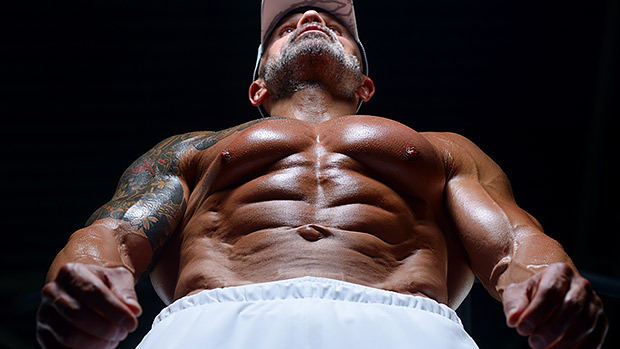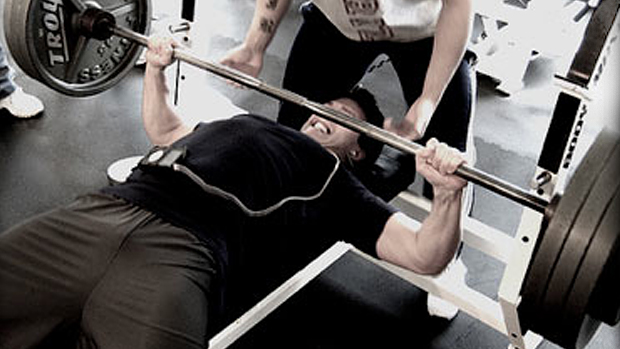Most Ab Training Programs Suck
Why? Because they fail to deliver the total package: a strong, athletic core that looks great, staves off injury, and actually improves performance in the gym.
If you want to have it all, you need to move beyond high-rep, one-dimensional abdominal exercises. Crunches, leg raises, and the deluge of isometric "anti" core exercises are good places to start, but they're not enough.
The human body is built for integrated movement across multiple planes and joints, which means your core muscles don't work in isolation. Rather, they work synergistically to create, absorb, stabilize, and facilitate movement with the rest of the body.
This happens in all three cardinal planes – sagittal, frontal, and transverse – which is why it makes sense to categorize core exercises along these lines rather than narrowly focusing on spinal movements like flexion, extension, and rotation.
Like the legs of a stool, each plane contributes to the movement of the whole. A program that integrates all the muscles involved in each plane translates into better real-world performance.
Here's how to do it, starting with the sagittal plane:
Humans are sagittal plane animals. Most of our lives are spent either moving back and forth, up and down, in a straight line, or balancing forces that occur during these movements. To create and stabilize sagittal plane movement, we rely on three primary muscles: the hamstrings, rectus abdominis, and external obliques.
90/90 Kettlebell Pull Over with Heel Dig
Think of this as a leg raise for your upper body, only you use your arms as the levers instead of your legs.
- Elevate your feet on a bench or step block. Dig your heels into the bench, roll your hips back, and slightly elevate your tailbone off the ground using your hamstrings.
- Holding a kettlebell over your chest, reach both arms toward the sky, bringing your shoulder blades off the ground and leaving only your head, upper, and mid-back still on the floor.
- Reach back, in the direction of your head, with the kettlebell. Inhale, moving your arms back about 2-3 inches. Exhale, flattening your lower back tight to the ground.
- Repeat for 4-5 breaths, moving your arms steadily back until you can't keep your back down any longer.
Eccentric Ab Pulldown
One of the primary roles of the abs is to transmit forces between the upper and lower body. In theory, that equates to isometric strength, which is why a lot of abdominal drills are done holding a static position.
The trouble is, in the real world of performance and athletics, you need a stable spine and rib cage because other muscles and joints are producing contrary and opposing forces. That's exactly what this exercise emulates.
- Sit on the ground holding a pair of cable attachments, as if you were going to do a lat pulldown.
- Dig your heels into the ground to activate your hamstrings and recline back until you're about at the halfway point of a sit-up.
- Round your back and roll your hips back.
- Pull the handles down and exhale fully. As the handles get closer to your body, the leverage changes, making it more difficult to keep the position.
Feet on Wall Front Plank
Front planks aren't anything new. Still, most people butcher them because they lack body position awareness. Putting the feet, especially the heels, against the wall provides a tactile reference point to activate the hamstrings and hold the pelvis in position against gravity.
- Start on your elbows and knees with your feet pressed flat against a wall.
- Walk your arms out until your elbows are 1-2 inches in front of your shoulders to create a long-levered plank.
- Drive your heels into the wall and, with your hamstrings, contract your torso towards your feet. Imagine you're pulling your back pants pockets to the back of your knee.
- Push your elbows through the ground, raising the upper back toward the ceiling and creating a hill instead of a valley between the shoulder blades.
Lateral weight-shifting, side-bending, and thoracic abduction – pushing your shoulders to one side without bending the spine laterally – are the hallmark movements of the frontal plane. The primary muscles in these movements are the internal and external obliques at the rib cage and the adductors at the hips.
Inch Worm Toe Touch
Inchworms combine sagittal and frontal plane muscles into an integrated exercise for the upper and lower body.
- Start from a push-up position – ribs pulled down and back, like you're trying to tuck the bottom of your rib cage into the side pockets of your pants. Keep your back slightly rounded throughout.
- Push the floor away with your left hand as you reach your right hand across your body toward your left foot, shifting your center of gravity to the left side.
- Exhale as you reach to get the air out of your lungs, allowing for a deeper reach.
- Alternate sides.
Oblique Hip Lift
Walking and running involve both forward propulsion and shifting our center of gravity from side to side as we transition weight from one foot to the other. To do this effectively requires the coordinated action of our obliques and adductors to keep our center of gravity over our base of support.
- Start on your left side in a traditional side plank position. Your top leg should be slightly in front of your bottom leg. Your left side should be shorter – as measured from hip to armpit – than your right.
- Bring your left knee and right elbow together in a cross-body crunch action. Inhale to drive air into your upper back and right side.
- Exhale and bring the knee and elbow back to the start.
- Repeat on the other side.
Cable Chop with Weight Shift
Chops and lifts are an easy way to introduce force vectors into the frontal and transverse planes. Here, we take a traditional cable chop and concentrate the load in the frontal plane by adding a lateral weight shift, stacking the shoulders and hips over one foot.
- Grab a rope attachment in both hands and shift all of your weight onto your right foot.
- Exhale and pull the cable across your body as you transition weight from the right foot to the left.
- End with your center of gravity over the left foot.
- Repeat on the other side.
Transverse plane exercises build rotational competency for throwing, punching, reaching, swinging, and pulling with one arm. This happens through a combination of internal and external obliques, turning the rib cage to one side or the other with the glutes rotating the pelvis in the same direction.
Quarter Turkish Get-Up with Bridge
Get-ups are a great way to integrate shoulder, rib, and hip mechanics in a single move, but you don't always need to do the full exercise. Adding the angled hip bridge from the elbow-supported position allows you to keep the focus on your abs while pulling the nearside glutes into the equation for extension and external rotation.
- Lie on the ground with a kettlebell in your right hand and your right foot flat on the ground.
- Reach and roll up and across your body, keeping your right arm perpendicular to the ground, transitioning your bodyweight to the left elbow and forearm.
- Drive your right foot into the ground and rotate your knee outward as you lift your hips off the ground.
- Repeat on the other side.
Landmine Rotations
The landmine is a great tool for loading rotational movements in a way that medicine balls or bodyweight exercises can't.
- Grab the end of the barbell with both hands. Keep your arms straight and your feet shoulder-width apart.
- Lower the weight toward your right hip as you rotate your hips in the same direction.
- Push the weight back to the middle, repeating the process in reverse on the other side.





